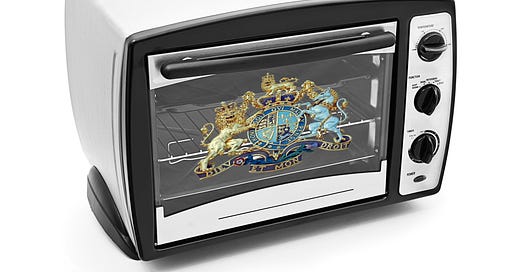January 6, 2021, is a day that will live in infamy. Or possibly Palm Beach. On this fateful day, the fragile United States Government was nearly toppled from its foundations, when dangerous blue-haired grandmothers and beer-bellied rednecks stormed the Capitol building. One of the members of the crowd snagged Nancy Pelosi’s lectern, cementing the overthrow.
For a few frightening days, the United States of America teetered towards mortal danger until the lectern was returned.
That’s how close we came to losing the Republic that day.
There is much to be learned from this near-catastrophe, and History is replete with examples of governments, liberties, and, yes, even lives lost when a nation’s precious governing objets are captured by hostile elements.
18 Brumaire
After his successful Egyptian military campaign in October 1799, Napoleon Bonaparte began scheming to overthrow the French government. On 9 November 1799, he abolished the five-member French Directory and replaced it with the 3-member Consulate, of which he was the only voting member. Wearing a horned helmet and face paint, he proclaimed himself Le Poubah Grande, while brandishing the Royal Swingline® Stapler. The name of the coup comes from the date of the incident, 18 Brumaire, Year VIII under the French Republican Calendar. He got rid of that too, eventually.
One significant and deadly outcome of this coup was Napoleon starting numerous big wars, and naming them after himself, in a similar vein as the Ukraino-Pelosi conflict of today.
The Xinhai or Hsinhai Revolution
Also known as the Chinese Revolution or the 1911 Revolution, it commenced with the 10 October 1911 Wuchang Uprising. As with many popular uprisings, this was ignited by an outrageous act of the then-current government, the Qing Dynasty. In a proclamation on 3 October 1911, the ethnic minority Manchus declared that the majority Han citizenry would only be allowed to use splintery chopsticks and would be required to communicate with half-baked ideograms.
The citizenry revolted by storming the official Qing Bamboo Depository, using their ill-gotten weapons to drive the Manchus out of power through a liberal dose of ouchies. Thus the government was replaced by the Han Ouchies who got to keep all the woks, reigning until the Communists took power and killed everyone.
The Glorious Revolution
Also called the Revolution of 1688, it began with the ouster of King James II of England (VII of Scotland) in that same year. An invading army led by William of Orange County consisting of blue-collar workers incensed by the extravagant lifestyles of snooty Hollywood types, installed Bill as William III of England. In the time-honored tradition of coup d’état, forces seized the Royal Toaster Oven, and, for good measure, the Air Fryer. William installed Robert of Reich as his propaganda minister.
It has been argued that this revolution began the modern English parliamentary democracy which remained the most-free system of government until abolished by dementia-influenced fiat in late 2022.
The Cuban Revolution
This was possibly the most famous coup of all time. On 26 July 1953, Fidel Castro sent a ragtag group of 160-odd, odd rebels to attack the Moncado and Bayamo military barracks and capture General Fulgencio Batista’s store of My Pillow® Egyptian-cotton bedsheets and plush mattress toppers. This revolt was financed by poster, t-shirt, and onesie sales featuring the visage of the brave, bloodthirsty leader of the contingent, Ernesto “Che” Guevara.
This revolution, underwritten by upper-middle-class American college students, was ultimately successful after a prolonged, bloody conflict when the regime eventually acquired sufficient dryers to give the captured My Pillows a 15-minute tumble.
Muammar Gaddafi
Twenty-seven-year-old junior army officer Gaddafi had a bone to pick with the Libyan monarchy. So he overthrew it on 1 September 1969 when King Idris was vacationing at a health resort (wink). He and about 70 co-conspirators drove military vehicles into the cities of Tripoli and Benghazi, and without firing a shot captured the King’s favorite Barcalounger. For the ensuing 42 years, Gaddafi engaged in all manner of perverse whims and sick fantasies at the expense of ordinary Libyans.
His reign finally fell after failed negotiations with Mike Lindell to supply the cotton for his bedsheets. He was outbid by the Egyptians and subsequently executed in the back of a Nash Rambler station wagon by Hillary operatives.
The Beer Hall Putsch
Inspired by Benito Mussolini’s March on Rome, Adolf Hitler led over 2,000 Nazis to take over a beer hall in Munich, Bavaria, apparently mistaking it for the Berlin Reichstag. Sixteen Nazis were killed in the ensuing battle with police. Hitler was arrested and thrown in jail where he wrote Mein Kampf after the Cliff Notes version was smuggled into the prison by a concubine of Adolf Eichmann.
After serving a mere eight months in a minimum-security prison, Hitler was released and after a series of passionate, consonant-littered, spittle-spewing speeches, conned the German people into awarding him the official Führer’s Lederhosen and a monogrammed beer stein.
The October Revolution
Known also as the Bolshvka Revolution, this coup took place in October 1917 as the second phase following the February Revolution. The Bolsheviks were pretty pooped after the February gambit and subsequently took a seven-month hiatus to practice restorative meditation and receive vodka treatment. After a series of actions too trivial to enumerate, the Bolshies captured the Winter Palace on 25 October and gained control of the Tzar’s favorite chess set and the Tzarina’s prized nested eggs, effectively ending the reign of Tzar Nicholas. Then they killed the entire family.
History has witnessed many other coups and revolutions, but these examples clearly demonstrate that to overthrow a government, it is never enough to merely take over important buildings and kill a lot of people. Without possession of critical furniture and possessions, true control is illusory.
The takeaway? In the name of all that is Holy, please bolt Nancy’s lectern to the floor.



